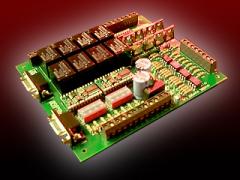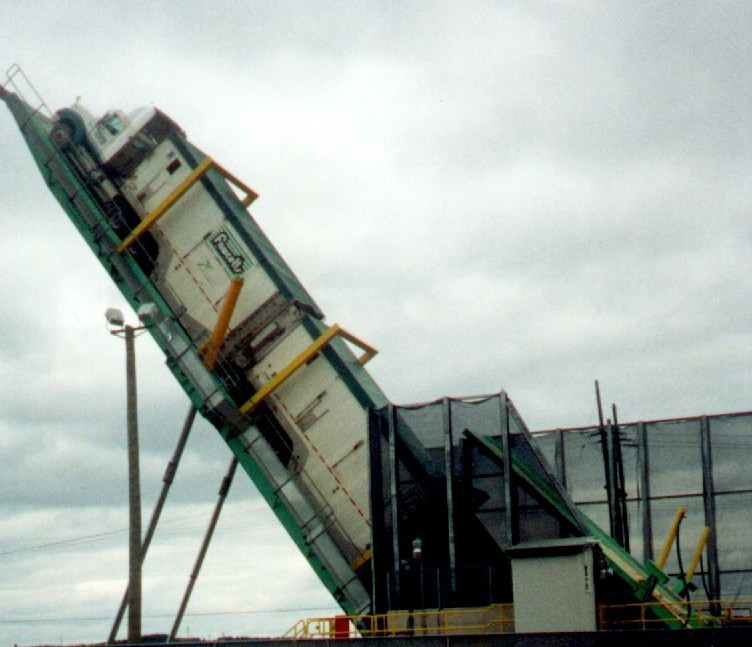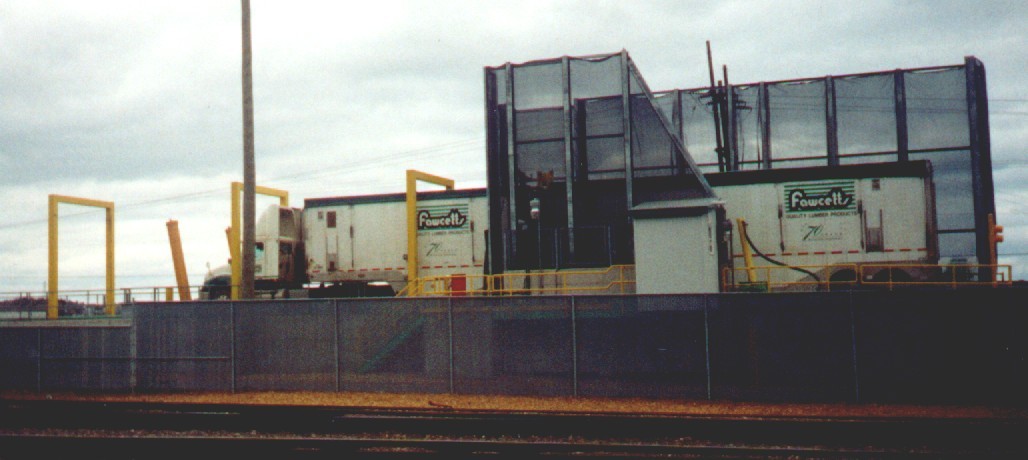Industrial truck dumper
· Here is project I completed related to an automated truck dumper at a pulp mill in eastern Canada.
· The Stamp sx does a couple of things. When a driver comes into the booth, he has a load slip that has been generated by the automated truck scales located just out of view to the right. The load slip has one or more lines of bar-code which contain his ID number, time of day ,the species of wood and whether or not a sample of chips has to be taken from this load. It also confirms that this particular truck should be dumped here and not at one of the other dumpers on the mill site.
··· The driver scans his load slip barcodes and the Stamp sx grabs that informatiom. If the slip indicates that a sample is to be taken, the Stamp sends that data to a printer in the basement area. The printer spits
out a sample identifying slip which drops in the sample pail ( about 5 gallons ). The sampler is a carousel type with a magazine of 24 pails. The actual sample is taken "on-fly" after the truck has been dumped as the chips go by on a conveyor belt about 44 feet per second. On average, a sample is taken from every 5th to 10th truck.
··· The the Stamp issues a command to the PLC that controls the dumper and the hydraulic system opens the bin floor and starts raising the truck. When the truck reaches a certain angle, both trailers empty with a tremendous whoosh. The two-trailer B-train shown brings in about 110,000 lbs of softwood chips in a single load.
··· The Stamp circuit board as shown is located in the grey "phone booth" near the back end of truck. It was chosen for this job because of the simplicity of serial interfacing to the barcode scanner and the printer. As well, the circuit board I used gave digital I/O to talk to the PLC and to provide the other control functions needed.
· The Stamp sx does a couple of things. When a driver comes into the booth, he has a load slip that has been generated by the automated truck scales located just out of view to the right. The load slip has one or more lines of bar-code which contain his ID number, time of day ,the species of wood and whether or not a sample of chips has to be taken from this load. It also confirms that this particular truck should be dumped here and not at one of the other dumpers on the mill site.
··· The driver scans his load slip barcodes and the Stamp sx grabs that informatiom. If the slip indicates that a sample is to be taken, the Stamp sends that data to a printer in the basement area. The printer spits
out a sample identifying slip which drops in the sample pail ( about 5 gallons ). The sampler is a carousel type with a magazine of 24 pails. The actual sample is taken "on-fly" after the truck has been dumped as the chips go by on a conveyor belt about 44 feet per second. On average, a sample is taken from every 5th to 10th truck.
··· The the Stamp issues a command to the PLC that controls the dumper and the hydraulic system opens the bin floor and starts raising the truck. When the truck reaches a certain angle, both trailers empty with a tremendous whoosh. The two-trailer B-train shown brings in about 110,000 lbs of softwood chips in a single load.
··· The Stamp circuit board as shown is located in the grey "phone booth" near the back end of truck. It was chosen for this job because of the simplicity of serial interfacing to the barcode scanner and the printer. As well, the circuit board I used gave digital I/O to talk to the PLC and to provide the other control functions needed.






Comments
▔▔▔▔▔▔▔▔▔▔▔▔▔▔▔▔▔▔▔▔▔▔▔▔
Chris Savage
Parallax Tech Support
csavage@parallax.com
At these softwood kraft mills, it takes lots of wood chips: up to 175 van loads a day at peak times, so its important to unload the trucks quickly. Whats not apparent in the photos is that the chips from the forward van actually push open the their doors and the chips pass through the rear van.
When up in the air, the trucks are completely supported by a really heavy steel gate at the rear bumper of the rear van. The trucks are left with very little weight on their tires and if there's any bounce in the hydraulics, the tires will actually come off the deck. Those big yellow "roll bars" on the dumper are there for a reason!
The board picture does indeed have two chips in it. When I designed it, the thought was that in some cases it might be nice to use two processors for added flexibility. The board has been very successful, and in fact, way back in 1996 - 1997, we sent one to Ken Gracey to have a look at. I bet its in the bottom drawer of his desk! Anyway, Ken's feedback let us get a good run out of the board.
I've got a couple of other "heavy duty" apps, if you're interested.
Cheers,
Tom Sisk
·· Very nice indeed!· If you have some apps that you want to post, by all means, do so.· Any finished project showing the BASIC Stamps or SX Micros in use are welcome here.· Picture and code are encouraged, but not required.· But pictures sure make it easy to appreciate!·
▔▔▔▔▔▔▔▔▔▔▔▔▔▔▔▔▔▔▔▔▔▔▔▔
Chris Savage
Parallax Tech Support
csavage@parallax.com
▔▔▔▔▔▔▔▔▔▔▔▔▔▔▔▔▔▔▔▔▔▔▔▔
·1+1=10
As part of the safety procedure, the driver is the one who has to enter the booth and operate the controls. The controls have a "dead-man" feature so a control handle has to be held during the cycle. Luckily, these trucks generally run with only one driver, so we haven't seen any surprized guys waking up in the sleeper.
As well, most drivers quickly find out that its best to shut off their engines as the lube oil tends to pool at the back of the engines when lifted to the max!
Cheers
▔▔▔▔▔▔▔▔▔▔▔▔▔▔▔▔▔▔▔▔▔▔▔▔
John J. Couture
San Diego Miramar College
little brains for big muscles!! (like me! haha)....nice to see a wee guy like the stamp doing giant things!!
▔▔▔▔▔▔▔▔▔▔▔▔▔▔▔▔▔▔▔▔▔▔▔▔
·
Steve
"Inside each and every one of us is our one, true authentic swing. Something we was born with. Something that's ours and ours alone. Something that can't be learned... something that's got to be remembered."
Glad to see you're still doing this project - I still have the relay board at Parallax!·
You neglected to mention another important application of the same hardware design - the Wastewater Management Control System for Saint John’s new control system for the Lancaster lagoon in New Brunswick. In that application, you're managing aeration with big 220 HP blowers.
In fact, it's·on our web site:
Wastewater Management Controller
Your designs are·really inspirational for us at Parallax. ·People who are new to electronics (and Stamps) often find it hard to believe that something so small can be involved in such a big job.
Ken Gracey
Parallax, Inc.
Great to hear from you. I'm glad the original beta board is still around. The current one is very similar, of course, but with added features, better silk-screening.
The Wastewater project is still clicking along, the project is not new any more , and we duplicated the work in a couple of other municipalities. Its original Stamps are still intact, it saves them $45,000 a year in power, provides trending, uses both data radios and hardwire RS-485 communications.
As I mentioned to Chris, I'll upload some other stuff as long as there's some interest.
Regards,
Tom Sisk
·· I think you've got that (Interest) in Spades...We appreciate the contributions.· Now Ken is going to have to bring that board by my desk so I can check it out!·
▔▔▔▔▔▔▔▔▔▔▔▔▔▔▔▔▔▔▔▔▔▔▔▔
Chris Savage
Parallax Tech Support
csavage@parallax.com
Disconnecting a trailer means:
1. Lowering support legs on the trailer.
2. Disconnecting electrical and hydraulic/pneumatic lines.
3. Moving the truck away.
While this doesn't take a lot of time, it'll take at least two or three minutes.
Factor in the same tim for reconnecting and you end up with a total of 4 - 6 minutes. (No, you can't speed it up by leaving the driver in the seat and letting someone else do the connections/legs. Not only is there a safety aspect, but most truckers won't trust anyone else to do it right, anyhow)
How many loads do they process each day?
175 loads multiplied by 4 is 700 minutes, or 11Hours, 40minutes 'wasted' on a dumping process which takes how long?
(6 minutes would multiply up to 17.5 hours...)
▔▔▔▔▔▔▔▔▔▔▔▔▔▔▔▔▔▔▔▔▔▔▔▔
Don't visit my new website...
Thanks for the interest.
You've hit a couple issues bang on.
Time on the dumper is about 5 minutes. But, the truck also has to weigh-in, weigh-out, get transaction slip, etc. Best case on site is probably 9 minutes if there's no-one ahead of you. Actual average time on the mill site is therefore nearly 17 minutes. Still faster than any other economical way.
If you work the math out, you'll see that the other two back-on dumpers are still required to cover maintenance days, storm days and break-downs.
Tom Sisk
emsonsjacks@gmail.com
▔▔▔▔▔▔▔▔▔▔▔▔▔▔▔▔▔▔▔▔▔▔▔▔
All my exes live in Texas
Oh yeah, all my exes are six feet under the ground!!!
One was a lineman who violated the one hand rule.
The·second put his tongue on 10 car batteries wired in series.
The third was involved in a tesla coil experiment gone bad.
Post Edited (kingneb) : 10/22/2005 3:47:03 PM GMT
This unit has the capacity to unload normal body trucks / trailers. there are associated problems with the trucks when tipped through 40 to 55 degrees , yet the truck owners are compensated for modifications / damage by the factory management , since its more ecomoical than use tippers / normal body trucks and unload them inb any other way.
They're also not very popular along the road...
(Particularly the BIG ones)
IF children laughs, consider that a bonus... :-)
(Then fire the schmuck who let small children into an industrial area...)
Why use the SX chip?
IF the system doesn't need the execution-speed of an SX, why not take advantage of the development-speed of the BS2?
(with the total cost of such a system, I doubt the price difference is going to matter)
▔▔▔▔▔▔▔▔▔▔▔▔▔▔▔▔▔▔▔▔▔▔▔▔
Don't visit my new website...
··· Amazing how much interest these posts generate!
·· The problem with dumper trucks has two sides: the first is that they just can't carry enough payload. The dual -trailer van system has the cubic volume to carry enough chips to make it worthwhile. The big dump trucks are designed for lots of weight, but don't need the volume. The second is that the empty weight of the dump truck is quite high compared to the van trailers. Travelling empty burns up your profit!!
· As to the SX, the only SX at the time was the bs2sx which still is my favorite for the types of systems I build.
· As for viewing the system, the kids can stand safely out of the way in a public area!
· Regards,
· Tom
·
···· I know we're drifting off topic, but it really points up an important industrial safety issue when doing a Stamp or any other project that brings together a team of several people or departments or consultants. EVERYBODY has to stay attuned to potential risks and talk over the ways of controlling the risks.....even if they are "someone elses" problem.
··· In this dumper project, there were quite a few "risks" that had to be addressed. For instance, what if a hydraulic hose burst on the main lift cylinders? What if the backstop gate wasn't locked before the truck is tipped up? These and a thousand other points were discussed and interlocked, many times both electrically and mechanically. Don't forget, we're talking a 7-figure investment before you dump the first truck, so having to tell your boss that·you didn't take 2 hours to talk to the mechanical designer or hydraulic designer·sounds pretty silly.
· The case in point is another example. How do you make sure a diesel fuel tank won't rupture while the truck is up? Well, in this case, it starts by having every truck maintain higher safety requirements than might otherwise be required. This includes high quality tanks with leak-proof vents and caps. The trucks are used only on paved roads in general so aren't subject to flying gravel, etc.
·· Also, everyone using the system is trained specifically to spot operational hazards and when to call in professional help.
·· Happy to continue this discussion outside the forum if anyone's interested.
·Cheers,
·Tom Sisk
Guess the driver does not have an open coffee cup in there with him.
Should see how the coal cars are thawed and dumped at NIT in Norfolk, Va. That at one time was controlled by a Coco running FORTH
FF